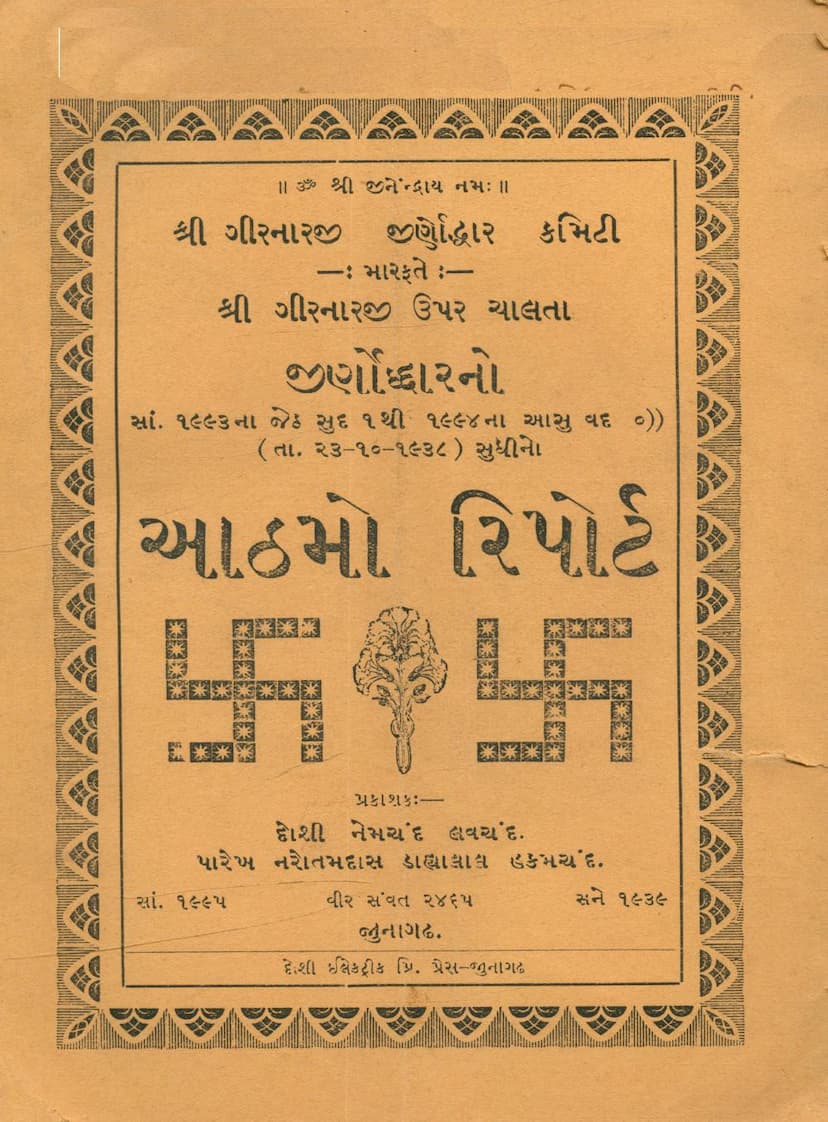Girnar Jirnoddharno Aathmo Report
Added to library: September 1, 2025

Summary
Here is a comprehensive summary of the provided Jain text, "Girnar Jirnoddharno Aathmo Report" by Doshi Nemchand Lavchand:
This document is the eighth report from the Girnar Jirnoddhar Committee (Shri Girnarji Renovation Committee), covering the period from Jeth Sud 1, Samvat 1993 (V.S.) to Ashwin Vad 0)), Samvat 1994 (V.S.) (October 23, 1938). The report details the progress and financial accounts of the renovation and restoration work undertaken at the sacred Jain pilgrimage site of Girnar.
Key aspects and content of the report include:
- Publisher and Editors: The report is published by Doshi Nemchand Lavchand and Parekh Nurotamdas Dahyalal Hakamchand. The accounts have been edited by R. R. Prabhashankar Hirambhai.
- Spiritual Guidance: The report is dedicated to and acknowledges the spiritual guidance of Acharya Shri Vijaynitissurishwarji Maharaj, a highly revered and accomplished Jain scholar and spiritual leader. His birth, initiation, and installation as Suri Maharaj dates are mentioned.
- Purpose of the Report: The primary purpose is to present the progress of the extensive renovation work at the ancient and revered Girnarji Tirth. The seventh report had already detailed the historical and mythological significance of the tirth, so this report focuses specifically on the renovation efforts.
- Acknowledgement of Support: The committee expresses gratitude to all organizations, individuals (sadgrihasthas), and community members who have contributed financially and otherwise to the renovation project.
- Financial Details (Anks 1-10):
- Ank 1 (Summary Account): Provides a comprehensive overview of income and expenditure from Jeth Sud 1, Samvat 1993 to Ashwin Vad 0)), Samvat 1994. It lists various sources of income, including direct collections, interest, and specific donations, and details the expenses incurred for different renovation activities.
- Ank 2 (Location-wise Collections): Lists the amounts collected from various locations and individuals for specific parts of the renovation, such as the "Ganadhar Pagla" (footprints of Ganadhar deities) and inscriptions.
- Ank 3 (Miscellaneous Income): Details miscellaneous income generated during the period, including sale of materials, interest, and contributions from various sources.
- Ank 4 (Marble Work Expenses): Provides a detailed breakdown of expenses related to the extensive use of marble in the renovation work, including material costs, labor, transportation, and miscellaneous charges for various structures and decorative elements.
- Ank 5 (Plaster, Painting, and Repair Expenses): Details the costs associated with plastering, painting, and general repair work undertaken on various parts of the temples and structures.
- Ank 6 (Shahabadi Tile Work Expenses): Outlines the costs related to the installation of Shahabadi tiles.
- Ank 7 (Chinese Work Expenses): Details the expenses incurred for specific "Chinese" style work.
- Ank 8 (Dome and Lattice Work Expenses): Accounts for the costs of renovating domes and lattice work.
- Ank 9 (Post-Report Period Collections): Lists collections received after the finalization of the report but before its publication.
- Ank 10 (Stock of Materials): Lists the stock of materials, particularly various types of marble, held at the end of Samvat 1994.
- Detailed Expenditure Breakdowns (Anks 11-140 onwards): The majority of the report consists of detailed financial statements (Anks 11 through Ank 195, and further sections) meticulously listing contributions and expenses for specific renovation tasks at various locations within Girnar Tirth. These include:
- Marble and Stone Work: Extensive details on marble usage for pillars, inscriptions, flooring, carvings, etc., across different temples and structures like the main temple of Nemnath Dada, Sangram Soni's temple, Ganadhar Pagla, and various "bhamtis" (corridors or walkways).
- Plastering and Painting: Costs for plastering, whitewashing, and painting various parts of the temple complexes.
- Specialized Work: Expenses for "Chinese" work, Shahabadi tiling, dome and lattice repairs, and other specific renovation tasks.
- Material Costs: Details on the cost of various materials used, including cement, lime, colors, wires, tools, etc.
- Labor and Transportation: Costs for artisans, laborers, and the transportation of materials.
- Contributions from Locations: The reports also show contributions received from specific cities and towns (e.g., Bhavnagar, Ahmedabad, Surat, Mumbai, Jamnagar, etc.) and list the names of donors and the amounts they contributed for particular renovation works.
- Ongoing Work and Future Needs: The report mentions that while significant progress has been made, some renovation work remains, specifically on the "ket" (likely meaning shikhar or spire) and lattice work of the Sangram Soni temple, and paving of some temple courtyards. The committee appeals for continued support from the Jain community to complete these remaining tasks.
- Call to Action: The report concludes with a clear appeal for continued financial assistance from philanthropic individuals and the community to ensure the successful completion of this vital religious undertaking, highlighting the opportunity for donors to have their names inscribed on the structures.
In essence, this report serves as a transparent account of the substantial efforts and financial transactions involved in the vital restoration of the historic and sacred Girnar Tirth, guided by spiritual leadership and sustained by community generosity.